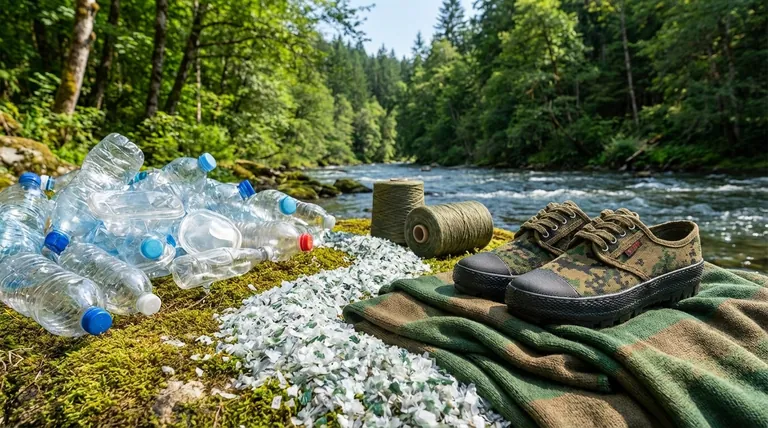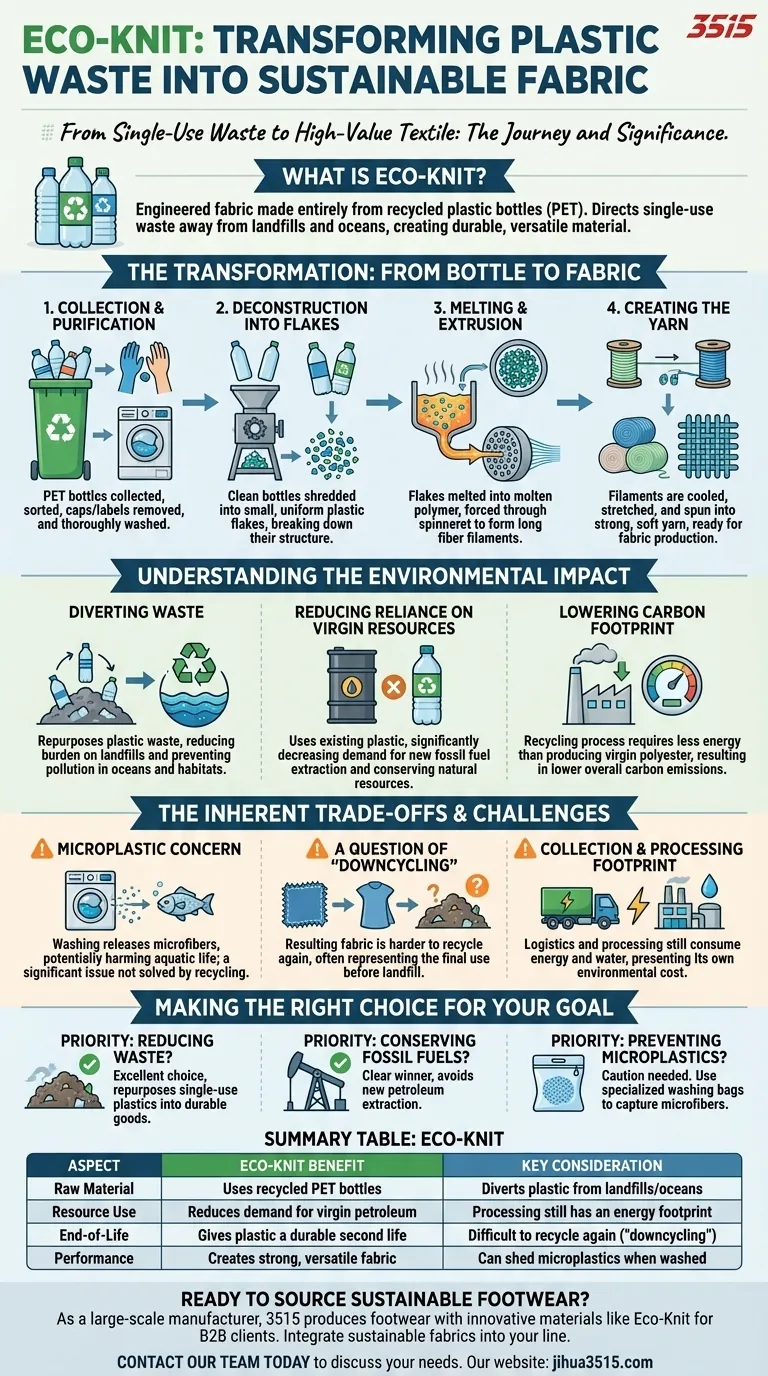At its core, Eco-Knit is a textile engineered entirely from recycled plastic bottles. This fabric directly addresses the global environmental crisis of single-use plastic waste by transforming discarded items, which would otherwise pollute landfills and oceans for centuries, into a durable and versatile material.
While the concept of recycling plastic is not new, the significance of Eco-Knit lies in its ability to convert low-value, single-use waste into a high-value, long-lasting product, effectively intercepting the path from consumer to landfill.

The Transformation: From Bottle to Fabric
Understanding how a rigid plastic bottle becomes a soft textile reveals the ingenuity of the process. It's a multi-step journey of mechanical and chemical transformation.
Step 1: Collection and Purification
The process begins with the collection of PET (polyethylene terephthalate) plastic bottles. These bottles are meticulously sorted, and their caps and labels are removed before they are thoroughly washed to eliminate any contaminants.
Step 2: Deconstruction into Flakes
Once clean, the bottles are fed into grinders that shred them into small, uniform plastic flakes. This step breaks down the structure of the bottle into a raw material that is much easier to process.
Step 3: Melting and Extrusion
The clean plastic flakes are melted down into a thick, molten polymer. This liquid is then forced through a device with tiny holes, called a spinneret, to form long, thin filaments of fiber.
Step 4: Creating the Yarn
These newly formed filaments are cooled, stretched, and spun together to create a strong, soft yarn. This recycled polyester yarn is the fundamental building block of the final Eco-Knit fabric, ready to be woven or knitted into textiles.
Understanding the Environmental Impact
The "eco" in Eco-Knit isn't just a label; it represents tangible benefits that address critical points in the manufacturing and waste lifecycle.
Diverting Waste from Ecosystems
With nearly one million plastic bottles purchased globally every minute, a vast number end up as pollution. Eco-Knit provides a direct pathway to repurpose this waste, reducing the burden on landfills and preventing plastics from entering oceans and natural habitats.
Reducing Reliance on Virgin Resources
Conventional polyester is derived from petroleum, a non-renewable resource. By using existing plastic as its raw material, Eco-Knit significantly decreases the demand for new fossil fuel extraction, conserving finite natural resources.
Lowering the Carbon Footprint
The energy required to recycle plastic and convert it into fabric is considerably less than the energy needed to produce virgin polyester from scratch. This results in a lower overall carbon footprint for the material.
The Inherent Trade-offs
No material is a perfect solution. An objective assessment of Eco-Knit requires acknowledging its limitations and the ongoing challenges associated with recycled synthetics.
The Microplastic Concern
Like all synthetic fabrics, washing garments made from Eco-Knit can release microscopic plastic fibers into waterways. These microplastics can harm aquatic life and are a significant environmental concern that the recycling process does not solve.
A Question of "Downcycling"
While often called recycling, turning a plastic bottle into fabric is more accurately described as "downcycling." The resulting textile is much more difficult to recycle again, meaning it often represents the final use for that plastic before it eventually reaches a landfill.
The Collection and Processing Footprint
The logistics of collecting, transporting, and processing plastic bottles still consume energy and water. While typically better than virgin production, this part of the lifecycle is not without its own environmental cost.
Making the Right Choice for Your Goal
Eco-Knit presents a compelling solution to one problem—plastic bottle waste—but it's important to align its use with your specific environmental priorities.
- If your primary focus is reducing plastic landfill waste: Eco-Knit is an excellent choice, as it directly repurposes single-use plastics into a durable good.
- If your primary focus is conserving fossil fuels: This material is a clear winner over virgin polyester, as it completely avoids the need for new petroleum extraction.
- If your primary focus is preventing microplastic pollution: You should be cautious with any synthetic fabric. Consider washing Eco-Knit garments in a specialized bag that captures microfibers to mitigate this issue.
By understanding both the innovative benefits and the nuanced limitations of materials like Eco-Knit, you are empowered to make more informed and truly sustainable choices.
Summary Table:
| Aspect | Eco-Knit Benefit | Key Consideration |
|---|---|---|
| Raw Material | Uses recycled PET bottles | Diverts plastic from landfills/oceans |
| Resource Use | Reduces demand for virgin petroleum | Processing still has an energy footprint |
| End-of-Life | Gives plastic a durable second life | Difficult to recycle again ('downcycling') |
| Performance | Creates a strong, versatile fabric | Can shed microplastics when washed |
Ready to source sustainable footwear?
As a large-scale manufacturer, 3515 produces a comprehensive range of footwear for distributors, brand owners, and bulk clients. Our production capabilities encompass all types of shoes and boots, including those made with innovative materials like Eco-Knit. We can help you integrate sustainable fabrics into your product line to meet growing consumer demand.
Contact our team today to discuss your manufacturing needs and build a more sustainable collection.
Visual Guide

Related Products
- Wholesale Durable Camo Canvas Shoes with High-Traction Rubber Soles
- Wholesale Comfortable Business Casual Shoes Custom Manufacturing
- Premium Wholesale Wheat Nubuck Safety Boot with Rapid Lacing System
- Durable Leather Work Boots Wholesale Manufacturer & Custom Factory
- Wholesale Modern Comfort Shoes with Dial Closure for Private Label & Bulk Orders
People Also Ask
- What is ASTM International and what does it do? A Guide to Global Standards
- What types of clothing are not considered business casual? Avoid These Common Style Mistakes
- What organization sets national standards for workplace safety in the U.S.? OSHA's Role Explained
- What is the purpose of ASTM International? A Guide to Global Quality Standards
- Do people never lack motivation to work out? The Truth About Fitness Consistency











